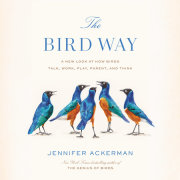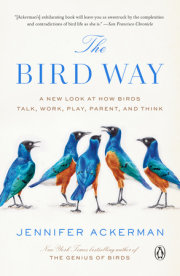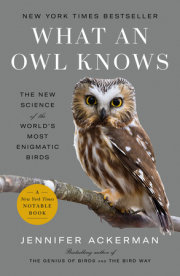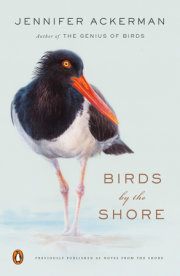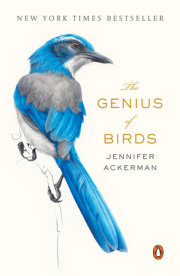Introduction
When You've Seen One Bird
There is the mammal way and there is the bird way." This is one scientist's pithy distinction between mammal brains and bird brains: two ways to make a highly intelligent mind.
But the bird way is much more than a unique pattern of brain wiring. It's flight and egg and feathers and song. It's the demure plumage of a mountain thornbill and the extravagant tail feathers of an Indian paradise flycatcher, the solo song of a superb lyrebird and the perfectly timed duets of canebrake wrens, an osprey's hurtling dive toward the sea, and a long-legged heron's still, patient eyeing of the dark water.
There is clearly no single bird way of being but rather a staggering array of species with different looks and lifestyles. In every respect, in plumage, form, song, flight, niche, and behavior, birds vary. It's what we love about them. Diversity fascinates biologists. It fascinates birdwatchers, too, driving us to assemble life lists, to travel to far corners of the globe to visit a rare species or jump in the car to spot a vagrant blown in by a storm, to go "pishing" and whistling into the woods to draw that elusive warbler.
Watch birds for a while, and you see that different species do even the most mundane things in radically different ways. We give a nod to this variety in expressions we use to describe our own extreme behaviors. We are owls or larks, swans or ugly ducklings, hawks or doves, good eggs or bad eggs. We snipe and grouse and cajole, a word that comes from the French root meaning "chatter like a jay." We are dodos or chickens or popinjays or proud as peacocks. We are stool pigeons and sitting ducks. Culture vultures. Vulture capitalists. Lovebirds. An albatross around the neck. Off on a wild goose chase. Cuckoo. We are naked as a jaybird or in full feather. Fully fledged, empty nesters, no spring chicken. We are early birds, jailbirds, rare birds, odd birds.
As biologist E. O. Wilson once said, when you have seen one bird, you have not seen them all.
This is certainly true for behavior. Take white-winged choughs. Australians say it's easy to fall in love with these birds-and it is. They're adorable, charismatic, gregarious, comical: lined up on a narrow tree branch, six or seven red-eyed puffs of black feathers, tenderly preening one another in a pearl-like strand of endearment and affection. Clumsy fliers, they prefer to walk everywhere, swaggering through dry eucalypt woodlands with their heads strutting backward and forward like a chicken's. They pipe and whistle and wag their tails like puppies. They're fond of playing follow-the-leader or keep-away, rolling over one another to win possession of a stick or a slip of bark. About the size of a crow but slimmer-black with elegant white wing patches and an arched bill-they live in stable groups of four to twenty birds and are always, always found in clusters or huddles or lines. Like a tight-knit family, they do everything together, drink, roost, dust bathe, play, run in wide formation like a football team to share a food discovery. Together they build big bizarre nests of mud (or emu or cattle dung if they're in a pinch) set on a horizontal branch, queuing up on the limb, waiting their turn to add their bit of shredded bark, grass, or fur soaked with mud to the rim of the nest. Together they brood, guard, and feed the young. Members of family groups are rarely more than five or ten feet apart. I once saw three fledglings jammed together on the ground like the three wise monkeys, see no evil, hear no evil, speak no evil.
And yet there's a darker side to choughs, especially if the weather turns bad. They squabble and fight, one group pitted against another. Larger groups gang up on smaller groups, flying at them and pecking viciously, dislodging eggs from nests, and nests from trees. They are known to go on violent crime sprees, ruining the nesting efforts of numerous other groups. One bird was observed picking up eggs in its bill one at a time and tossing them to the ground. Perhaps most unsettling, warring choughs do something few animals apart from humans and ants do: They forcibly kidnap and enslave the young from other groups.
This is a book about the range of surprising and sometimes alarming behaviors that birds perform daily, activities that firmly, sometimes gleefully, reverse conventional notions about what is ÒnormalÓ in birds and what we thought they were capable of.
Lately, scientists have taken a new look at behaviors they have run past for years and dismissed as anomalies or set aside as abiding mysteries. What they have found is upending traditional views of how birds conduct their lives, how they communicate, forage, court, breed, survive. It's also revealing the remarkable strategies and intelligence underlying these activities, abilities we once considered uniquely our own, or at least the sole domain of a few clever mammals-deception, manipulation, cheating, kidnapping, and infanticide, but also ingenious communication between species, cooperation, collaboration, altruism, culture, and play.
Some of these extraordinary behaviors are conundrums that seem to push the edges of, well, birdness: a mother bird that kills her own infant sons, and another that selflessly tends to the young of other birds as if they were her own. Young birds that devote themselves to feeding their siblings, and others so competitive that they'll stab their nest mates to death. Birds that create gorgeous works of art, and birds that wantonly destroy the creations of other birds. Birds like the white-winged chough that contain their own contradictions: one murderous bird that impales its prey on thorns or forked branches but sings so beautifully that composers have devised whole compositions around its songs; another with a reputation for solemnity that is strongly addicted to play; and another that collaborates with one species-humans-but parasitizes another in gruesome fashion. Birds that give gifts and birds that steal, that dance and drum, that paint their creations or paint themselves. Birds that build walls of sound to keep out intruders, and birds that summon playmates with a special call-and may hold the secret to our own penchant for playfulness and the evolution of human laughter.
Earth is home to well over ten thousand different species of birds, many with marvelous, often Seussian, names-the zigzag heron and white-bellied go-away bird, speckled mousebird and naked-faced spiderhunter, the Inaccessible Island rail, pale chanting goshawk, shining sunbeam, military macaw, and wandering tattler, a yellow-legged stanza of elegance I watched probe for crustaceans and worms on the fringes of a tiny island in AlaskaÕs Kachemak Bay. The wandering refers to its presence everywhere over vast stretches of sea. Tattler refers to the shrill tattling call to alert other birds if an observer approaches too closely. There are whydahs and widowbirds, fantails and fairy-wrens, broadbills and hornbills, and buff-breasted buttonquail (known as BBBQs). Birds live on every continent, in every habitat, even-like the burrowing owl and the Puerto Rican tody-underground. They run to extremes in everything from size and flight style to feather color and physiology. I once saw a biologist weigh a male broad-tailed hummingbird: one-seventh of an ounce. Compare this with the cassowary, a giant weighing one hundred pounds-around twelve thousand times the hummer-that looks as much like a dinosaur as any living bird, can rise up six feet to pluck fruit from limbs, and is capable of killing a man. Or consider the ten-foot wingspan of an Andean condor relative to the five-inch span of a goldcrest.
Some birds are agile fliers, like the northern goshawk, slalom king of the bird world, and swifts and hummingbirds, those avian acrobats. Big, flightless birds, such as the emu and the cassowary, don't take wing at all, although their ancient ancestors did. Likewise, the Gal‡pagos cormorant, used to have flight, but lost it over evolutionary time in favor of the grounded life. Seabirds such as the wandering albatross log tens of thousands of miles each year to return to tiny islands in the middle of vast oceans to breed. They may go for years without touching land and, when seas are rough, will sleep on the wing, one eye open to navigate. Bar-tailed godwits migrate from Alaska to New Zealand in a single 7,000-mile flight, traveling day and night for seven to nine days-the longest recorded nonstop migratory flight. In terms of flying distance, the Arctic tern takes all, circling the world in orbit with the seasons. The bird flies from its breeding grounds in Greenland and Iceland to its wintering grounds in Antarctica-a round trip of almost 44,000 miles, the longest migration ever recorded. Over the thirty years of its life, a tern may fly about 1.5 million miles, the equivalent of three trips to the moon and back.
As an astronaut who traveled to the International Space Station and made the first all-female space walk in 2019, Jessica Meir knows a thing or two about going to extremes. Meir's goal had always been to walk in space, and on her way to that dream, she explored the lives of two birds capable of truly exceptional physiological feats-one that holds its breath for impossibly long periods of time, the other that flies at breathtaking altitudes.
At Penguin Ranch in Antarctica, Meir investigated emperor penguins, the world's best bird divers. These penguins can dive deeper and longer than any other bird and can tolerate extremely low levels of oxygen in their blood-far below those that would render a human unconscious. Meir observed the birds diving for fish from an underwater viewing chamber. "They look like different animals underwater," she says, "like ballet dancers." The penguins routinely dive for 5 to 12 minutes at a time. One penguin made a 27-minute dive on a single breath. Meir wanted to understand how these animals can stay underwater for so long. "They're air breathers just like we are," she says. "They take a breath before they dive and then use the oxygen in that breath for the entire time they're down there." One of their secrets: They slow their heart rate from 175 beats per minute to around 57 beats per minute, which allows them to slow the use of their oxygen stores.
Later, Meir turned to a bird famous for one of the most extreme migrations on Earth. The bar-headed goose crosses the Himalayas twice a year on its migratory route from sea level in southern Asia up over the enormous mountain range to its summer breeding grounds in the central Asian highlands.
One cold April night in the high Himalayas, naturalist Lawrence Swan stood listening to the silence. From the south a distant sound came, a quiet hum that became a call, the honking of bar-headed geese. Swan followed their movement directly over the summit of Makalu. "At 16,000 feet, where I breathed heavily with every exertion," he writes, "I had witnessed birds flying more than two miles above me, where the oxygen tension is incapable of sustaining human life-and they were calling. It was as if they were ignoring the normal rules of physiology and defying the impossibility of respiration at that height by wasting their breath with honking conversation."
Flapping flight consumes ten to fifteen times more oxygen than resting. Most of these geese reach altitudes of 16,000 to 20,000 feet. One bird was recorded at almost 24,000 feet. At this altitude, oxygen levels are roughly a half to a third what they are at sea level. Bar-headed geese sustain the high oxygen demands of flight in air that is so thin that even the most elite human athletes can barely walk in it.
Meir wondered, do the birds use thermals, those upward currents of warm air, to save energy? "No, they actually fly at night and early in the morning, when there's a strong headwind and the temperature is lower," she says. Moreover, they're flapping fliers and almost never glide or soar. So how do they do it?
To find out, Meir decided to train them to fly in a wind tunnel. And to do so, she became Mother Goose, raising a gaggle of twelve goslings from birth so that they would imprint on her. "We would go for walks together, take naps together," she says. "It's true what they say about children, they grow up fast." She started the geese flying by riding a bike so that they would fly right next to her, almost beak to cheek. That worked for a day, but they were too fast, so she took to riding a motorcycle up and down small roads, the birds by her side, wingtips brushing her shoulders. "Looking into the eye of a bird like that is really special," she says. Eventually, Meir and her colleague Julia York of the University of Texas readied the geese for flight in the wind tunnel, fitting them with tiny backpacks that recorded their vital signs and with special custom-made masks that changed the oxygen content of the air they breathed to mimic those they might experience through the passes of the Himalayas and at the summit of Mount Everest. Then they set the birds flying in the tunnel to measure their heart rate, metabolic rate, blood oxygen levels, and temperature under different conditions.
Scientists knew that these geese have several adaptations that help them at high altitudes: larger lungs than other birds, more efficient breathing (deeper and less frequent), a kind of hemoglobin that grabs oxygen more effectively (allowing them to extract more of the gas from each breath of air than can other birds), and blood capillaries that are especially densely distributed throughout their muscles to deliver the oxygen. What Meir and York learned through their experiments was that the geese have yet another superbird mechanism: a unique response to temperature. In their bodies, the temperature difference between their cold lungs and their warm muscles can increase the delivery of oxygen by twofold during sustained flapping flight at high altitudes. The geese also minimize their metabolic rate, reducing the amount of oxygen they need to fly.
"But this isn't the whole story," says Meir. "We still don't know how these birds cope with the low barometric pressure at extremely high altitudes, which would do in other species."
It's what I love about so many aspects of bird biology and behavior. They're still layered with mystery.
Then there's the vast spectrum of plumage in the bird world, a riot of brilliantly hued buntings and carnival-colored parrots; the vibrant Palawan peacock-pheasant, its glossy blue-black feathers lustered with a dazzling metallic green; the red bird-of-paradise, with its filmy plumes and long plastic-like feather wires projecting from its tail, and its cousin, the paradise riflebird, with its outlandish super-black feathers created by unusual bristling microstructures that trap nearly all light; as well as the whiskered auklet of the Aleutian Islands, which sprouts acutely sensitive plumes from its head that guide it through its dark nest cavities in the nesting season.
Copyright © 2020 by Jennifer Ackerman. All rights reserved. No part of this excerpt may be reproduced or reprinted without permission in writing from the publisher.


